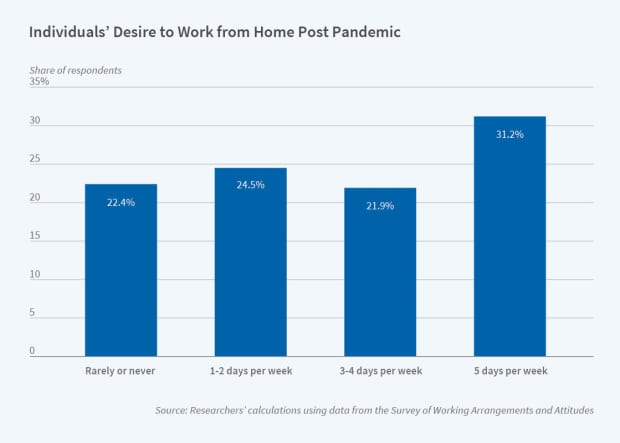# Here’s one financial reason why employees want to work from home — and employers had a hand in it

Table of Contents
“#
Here’s one financial reason why employees want to work from home — and employers had a hand in it
”
These findings are based on a poll of 30,000 workers taken monthly for a year.
Markers showing people how to stand six feet apart on the floors of stores and sidewalks may soon be relics of the pandemic as more Americans get vaccinated against coronavirus —- but working from home won’t be.
Some 20% of work in the U.S. post-pandemic will be performed remotely, a recent report circulated by the National Bureau of Economic Research titled “Why Working from Home Will Stick” suggests.
“
Americans spent $561 on average upgrading their work from home setups over the course of the pandemic.
”
“The dollar value of these investments amounts to 0.7 percent of annual GDP,” the authors of the report wrote.
Meanwhile, employers also invested resources to improve their back-end infrastructure systems.
“As a result of these pandemic-driven investments, both workers and firms are now better positioned to work from home effectively,” the authors added.

The report, written by three professors from Instituto Tecnológico Autónomo de México, Stanford University and the University of Chicago, is based on a poll of 30,000 working-age Americans who earned at least $20,000 in 2019.
The survey was conducted in monthly waves beginning in May 2020 through March 2021.
Prior to the pandemic, a quarter of American workers occasionally worked from home, according to a 2019 Bureau of Labor Statistics report.
Some 15% of all workers in 2017 to 2018 were required to work from home on certain days, according to the BLS report.
“
Going forward, more than 30% of all workers want to continue working from home five days a week after the pandemic.
”
As of March 2021, some 45% of work was being done at home, according to findings from the report circulated by NBER.
Other estimates, including those from the Economic Policy Institute, a progressive think tank, say only 1 in 5 people are able to work from home. “Specifically, only 1 in 6 Hispanic workers and 1 in 5 Black workers are able to telework due to COVID, compared with 1 in 4 white workers,” it said in a report released Wednesday.
Going forward, more than 30% of all workers want to continue working from home five days a week after the pandemic, while nearly 22% of workers said they never or rarely want to work from home after the pandemic, it said.
As vaccination rates continue to rise in the U.S. where more than half of all adults have been fully vaccinated, some workers won’t have a choice as more employers announce mandatory return-to-work dates.
“
Over the course of the pandemic, Americans have spent $561 and 15 hours of their own time on average to upgrade their work-from-home setups
”
Other employers are experimenting with a hybrid model — where workers can choose which day(s) to work in person and which day(s) to work remotely.
To incentivize workers to return back to offices, some employers are offering free spa retreats and meals for non-remote workers.
Like JPMorgan CEO Jamie Dimon, who recently said he was “done” with Zoom
ZM,
meetings, many employers don’t think working from home is sustainable in the long run and are eager to bring back water cooler chats and dust off conference room tables.
But there are some reasons why work from home isn’t going away entirely anytime soon, according to the NBER paper.
People are used to working from home
In the beginning of the pandemic, the transition to working from home was chaotic for many.
It wasn’t uncommon for people to work from their bathrooms, hallways or closets to avoid working on top of roommates or family members who they live with.
But more than a year later, most people who have been working from home have nailed down a routine that won’t be easy to change, the researchers said in the report.
The number of U.S. patent applications for products that help enable people to work from home more than doubled from January to September 2020.
“This development will raise the quality and efficiency of remote work over time, reinforcing a shift to WFH [work from home] well after the pandemic ends,” the report states.
See also: Companies and employees appear to have starkly different ideas about where they’ll work post-COVID
By
Elisabeth Buchwald
If you liked the article, do not forget to share it with your friends. Follow us on Google News too, click on the star and choose us from your favorites.
For forums sites go to Forum.BuradaBiliyorum.Com
If you want to read more News articles, you can visit our News category.




